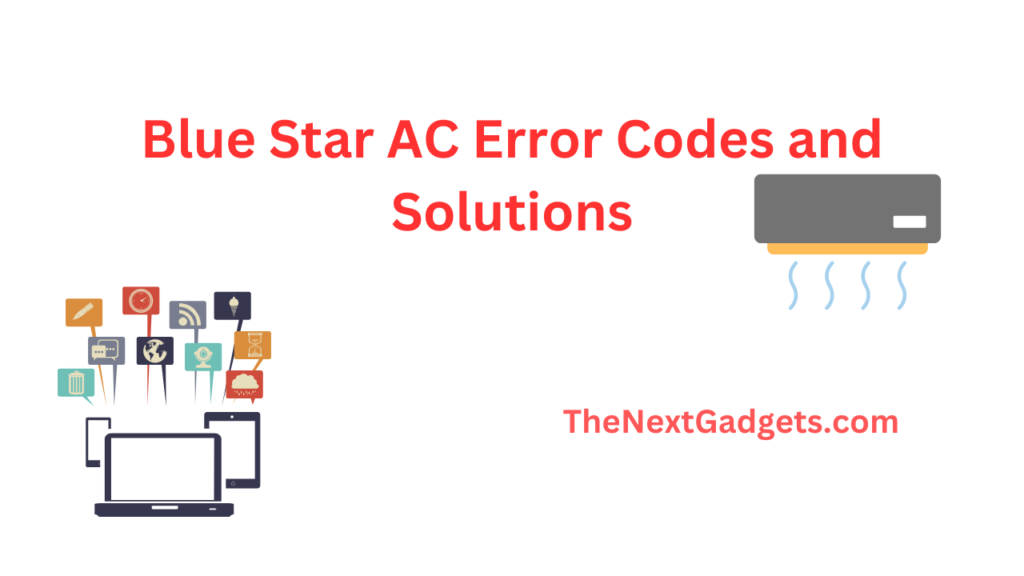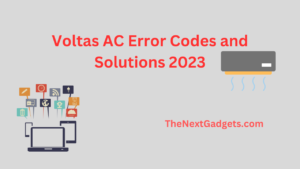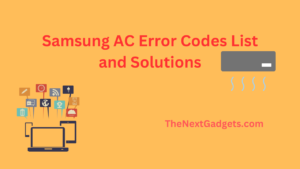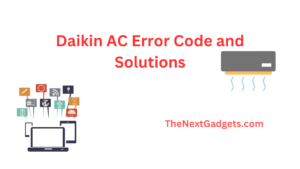Air conditioners have become an indispensable part of our lives, especially during the hot and humid summer months. Blue Star is a leading air conditioner manufacturer in India, known for its range of high-quality products. However, even the best air conditioners can malfunction or encounter errors. In this blog, we will take a look at some of the most common Blue Star AC error codes and how to troubleshoot them.

Table of Contents
Common Blue Star AC Error Codes
E1 Error Code
The E1 error code is a fairly common issue experienced by users of Blue Star air conditioners. This error code is indicative of a problem with the indoor temperature sensor, which, in turn, leads to a halt in the operation of the air conditioner and prompts the display of the E1 error code on the control panel.
To troubleshoot this error effectively, one should initiate the process by switching off the air conditioning unit and disconnecting it from its power source. Subsequently, one should carefully inspect the connection of the indoor temperature sensor to the main control board, ensuring that it is securely attached. In cases where there is a loose connection, it is recommended to reattach the sensor securely to the control board.
If, after a thorough inspection and reattachment, the sensor is found to be damaged or faulty, the next course of action is to replace it with a new, functional sensor. Following the replacement of the sensor, plug in the air conditioner and turn it on. If the error code no longer appears, this suggests that the issue has been successfully resolved.
E2 Error Code
The E2 error code is another fairly common error encountered by users of Blue Star air conditioners. This error code signifies a malfunction in the outdoor temperature sensor. When this error is detected, the air conditioner ceases its normal operation and presents the E2 error code on the display panel.
To effectively troubleshoot this error, it is necessary to commence by switching off the air conditioning unit and disconnecting it from its power source. Subsequently, the outdoor temperature sensor should be inspected to ensure that it is properly connected to the main control board. In the event that the connection is found to be loose, reattaching the sensor securely to the control board is essential.
If the sensor is found to be damaged or faulty, the appropriate course of action is to replace it with a new sensor. Following the replacement of the sensor, plug in the air conditioner and turn it on. If the error code no longer appears, this indicates that the issue has been resolved.
E3 Error Code
The E3 error code is an indicator of a malfunction in the indoor coil temperature sensor. When this error is encountered, the air conditioner ceases its normal operation and displays the E3 error code on the control panel.
To effectively troubleshoot this error, it is recommended to start by switching off the air conditioning unit and disconnecting it from its power source. Subsequently, the indoor coil temperature sensor should be carefully examined to ensure that it is appropriately connected to the main control board. In cases where the connection is loose, reattaching the sensor securely to the control board is essential.
If, after a thorough inspection, the sensor is found to be damaged or faulty, the next step is to replace it with a new sensor. After the replacement of the sensor, plug in the air conditioner and turn it on. If the error code is no longer visible, this indicates that the issue has been successfully resolved.
E4 Error Code
The E4 error code is indicative of a malfunction in the outdoor coil temperature sensor. When this error is detected, the air conditioner stops its normal operation and displays the E4 error code on the control panel.
To troubleshoot this error, it is necessary to begin by switching off the air conditioning unit and disconnecting it from its power source. Subsequently, the outdoor coil temperature sensor should be inspected to ensure that it is properly connected to the main control board. In cases where the connection is loose, reattaching the sensor securely to the control board is essential.
If, upon inspection, the sensor is found to be damaged or faulty, the recommended course of action is to replace it with a new sensor. After replacing the sensor, plug in the air conditioner and turn it on. If the error code is no longer visible, this suggests that the issue has been successfully resolved.
E8 Error Code
The E8 error code indicates a fault in the indoor unit’s room temperature sensor or its wiring. It may also be an indication that the indoor unit’s PCB is faulty. To resolve this issue effectively, it is advisable to seek the expertise of a qualified technician who can accurately diagnose and repair the problem.
E9 Error Code
The E9 error code is an indicator of a problem with the indoor unit’s evaporator coil temperature sensor. The sensor or its wiring may be faulty, or there may be a problem with the indoor unit’s PCB. In order to address this issue, it is recommended to involve a qualified technician who can properly diagnose and repair the problem.
F1 Error Code
The F1 error code indicates a communication problem between the indoor and outdoor units. This issue may be caused by a faulty control board or a wiring problem. To effectively resolve this matter, it is advised to engage a qualified technician who can diagnose and repair the problem accurately.
F2 Error Code
The F2 error code signifies a problem with the outdoor unit’s discharge pipe temperature sensor. The sensor or its wiring may be faulty, or there may be an issue with the outdoor unit’s PCB. To address this issue appropriately, it is advisable to consult a qualified technician who can effectively diagnose and repair the problem.
F3 Error Code
The F3 error code indicates a problem with the outdoor unit’s suction pipe temperature sensor. The sensor or its wiring may be faulty, or there may be an issue with the outdoor unit’s PCB. To rectify this problem, it is recommended to involve a qualified technician who can accurately diagnose and repair the problem.
F4 Error Code
The F4 error code signifies an issue with the outdoor unit’s compressor discharge temperature sensor. This problem can result from faulty wiring or a malfunctioning sensor, as well as potential issues within the outdoor unit’s PCB. To resolve this matter, it is necessary to rely on the expertise of a qualified technician who can diagnose and repair the problem effectively.
Also Read BEST 2 Ton 5 Star Split AC in India
F5 Error Code
The F5 error code is indicative of a problem with the outdoor unit’s discharge pressure sensor. The sensor or its wiring may be faulty, or there may be an issue with the outdoor unit’s PCB. To address this issue properly, it is recommended to engage a qualified technician who can diagnose and repair the problem accurately.
F6 Error Code
The F6 error code suggests a problem with the outdoor unit’s suction pressure sensor. The sensor or its wiring may be faulty, or there may be an issue with the outdoor unit’s PCB. To effectively resolve this issue, it is advisable to consult a qualified technician who can accurately diagnose and repair the problem.
F7 Error Code
The F7 error code is an indicator of a problem with the outdoor unit’s current sensor. The sensor or its wiring may be faulty, or there may be an issue with the outdoor unit’s PCB. To properly address this issue, it is recommended to involve a qualified technician who can accurately diagnose and repair the problem.
Conclusion
In summary, when faced with any error codes on your Blue Star AC, it is crucial to seek assistance from a certified technician for proper diagnosis and repair. Trying to address the problem independently may result in additional damage and could potentially void the warranty. Consistent maintenance and timely repairs are essential to ensure the continued smooth and efficient operation of your Blue Star AC in the future.
FAQ – Blue Star AC Error Codes
Q: What are some common Blue Star AC error codes?
A: Some common Blue Star AC error codes include E1, E2, E3, E4, E5, E6, E7, E8, E9, F1, F2, F3, F4, F5, F6, and F7.
Q: What does the E1 error code mean?
A: The E1 error code typically indicates a problem with the indoor unit’s room temperature sensor or its wiring.
Q: What should I do if I encounter the E2 error code?
A: The E2 error code usually indicates a fault in the indoor unit’s indoor coil temperature sensor or its wiring. It’s best to call a qualified technician for diagnosis and repair.
Q: How can I troubleshoot the E3 error code?
A: The E3 error code may indicate a problem with the indoor unit’s outdoor coil temperature sensor or its wiring. It’s recommended to contact a qualified technician for further diagnosis and resolution.
Q: What does the F1 error code signify?
A: The F1 error code typically indicates a communication problem between the indoor and outdoor units of the AC system. It may require professional diagnosis and repair by a qualified technician.
Q: How to resolve the F4 error code on a Blue Star AC?
A: The F4 error code usually indicates an issue with the outdoor unit’s compressor discharge temperature sensor or its wiring. It’s important to contact a qualified technician for proper diagnosis and repair.
Q: What should I do if I see the F7 error code on my Blue Star AC?
A: The F7 error code typically indicates a problem with the outdoor unit’s current sensor or its wiring. It’s recommended to seek assistance from a qualified technician for proper diagnosis and resolution.
Also Check out BEST Low Power Consumption AC in India (5 Star Air Conditioners)
Q: Can I fix Blue Star AC error codes myself?
A: It’s not recommended to attempt fixing Blue Star AC error codes yourself unless you have proper knowledge and experience. DIY repairs may cause further damage and void the warranty. It’s best to seek professional help from a qualified technician.
Q: How can I prevent Blue Star AC error codes?
A: Regular maintenance and timely servicing of your Blue Star AC can help prevent error codes. It’s important to follow the manufacturer’s recommended maintenance schedule and avoid any improper use or installation that may cause issues.



